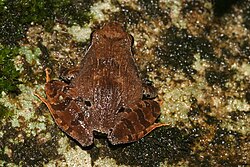Biology:Walkerana diplosticta
| Walkerana diplosticta | |
|---|---|

| |
| Scientific classification | |
| Domain: | Eukaryota |
| Kingdom: | Animalia |
| Phylum: | Chordata |
| Class: | Amphibia |
| Order: | Anura |
| Family: | Ranixalidae |
| Genus: | Walkerana |
| Species: | W. diplosticta
|
| Binomial name | |
| Walkerana diplosticta (Günther, 1876)[2]
| |
| Synonyms[3] | |
| |
Walkerana diplosticta, also known as the spotted leaping frog,[4] Malabar Indian frog,[5] rufous leaf-hopper frog, and Günther's frog, is a species of frog in the family Ranixalidae.[3] It is endemic to the Western Ghats south of the Palghat Gap and only known with certainty from the states of Kerala and Tamil Nadu, India .[3][6] Localities with confirmed records include the Kalakkad Mundanthurai Tiger Reserve.[6]
Description
Walkerana diplosticta is a relatively small frog reaching a snout–vent length of about 35 mm (1.4 in);[5] among specimens with species identification confirmed with genetics methods, two adult males measure 24 and 28 mm (0.9 and 1.1 in) and two adult females 23 and 26 mm (0.9 and 1.0 in) in snout–urostyle length. The canthus rostralis is distinct.[6] The tympanum is distinct and relatively large. The finger and toe tips bear discs. The toes are partially webbed. The dorsum is grey-pink or reddish-brown. The snout is paler and bordered by dark bar between the eyes. A brown stripe runs from the snout to the shoulder. The groin has brown spots. The ventrum is light brown with darker spots. The limbs are cross-barred.[5] Dorsal skin is smooth.[6]
Habitat and conservation
Walkerana diplosticta was assessed by the International Union for Conservation of Nature in 2004 and includes records[1] that are now considered requiring confirmation.[6] At the time, it was considered to be an uncommon species and believed to be declining. It is a terrestrial frogs found near hill streams in primary wet evergreen and semi-evergreen tropical forests and swamps; is not present in secondary forest or modified habitats. It breeds on wet rocks, and the tadpoles are found on wet rock surfaces next to streams.[1]
References
- ↑ 1.0 1.1 1.2 S.D. Biju; Sushil Dutta; Robert Inger; M.S. Ravichandran (2004). "Indirana diplosticta". IUCN Red List of Threatened Species 2004: e.T58309A11762447. https://www.iucnredlist.org/species/58309/11762447. Retrieved 20 January 2020.
- ↑ Günther, 1876. Proc. Zool. Soc. London, 1875: 574
- ↑ 3.0 3.1 3.2 Frost, Darrel R. (2020). "Walkerana diplosticta (Günther, 1876)". Amphibian Species of the World: an Online Reference. Version 6.0. American Museum of Natural History. http://research.amnh.org/vz/herpetology/amphibia/Amphibia/Anura/Ranixalidae/Walkerana/Walkerana-diplosticta.
- ↑ Daniels, Ranjit 2005, Amphibians of Peninsular India. Universities Press. p. 195
- ↑ 5.0 5.1 5.2 Venkataraman, K.; Chattopadhyay, A.; Subramanian, K.A., eds (2013). Endemic Animals of India (Vertebrates). Kolkata: Zoological Survey of India. pp. 235 pp.+26 plates. https://www.researchgate.net/publication/301693197. [Indirana diplosticta: p. 102]
- ↑ 6.0 6.1 6.2 6.3 6.4 Dahanukar, Neelesh; Modak, Nikhil; Krutha, Keerthi; Nameer, P. O.; Padhye, Anand D.; Molur, Sanjay (2016). "Leaping frogs (Anura: Ranixalidae) of the Western Ghats of India: An integrated taxonomic review". Journal of Threatened Taxa 8 (10): 9221–9288. doi:10.11609/jott.2532.8.10.9221-9288.
Wikidata ☰ Q3150486 entry
 |


